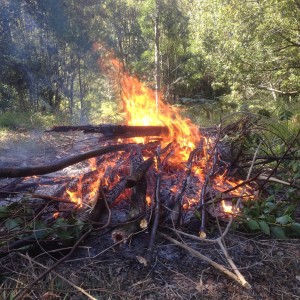There’s something primally satisfying about watching a fire burning-off, and Winter days give us the chance for burning-off some of the vegetation we have cleared in the previous months. There are two woody weeds in particular that we have a lot of; lantana and camphor laurel, and when we have a couple of spare hours we typically get out and clear some, which involves pulling out the lantana and cutting down the camphor laurel. The piles then sit until a winter day when it has been dry enough for a few days to burn.

Burning-off the rubbish
In this part of the world there are fire bans for most of the year, when we have to apply to have large open air fires, but in Winter it is safe to burn accumulated vegetation, provided we prepare the surrounds and watch it carefully, of course. We have been steadily burning rubbish piles for weeks now, but with my parents visiting and looking for jobs, I enlisted their help and we managed to clear a serious amount of dry branches from their rough piles on the ground. It’s pleasant work, making sure the surrounding grass is cleared, watching to make sure it stays contained, fetching and feeding in more branches, and feeding the unburnt ends in. Even green lantana burns once the fire is going well.
Afterwards there are just neat circles of ash and charcoal, and Dad even bagged some of that for easy addition to the vegetable beds. It will be a good conditioner for our acid soil. That’s the second advantage of burning. Ash contains the metallic elements like potassium, calcium and magnesium, and is quite alkaline, so it’s a great way of moving those valuable elements from the forest margins where the lantana and camphor grow, to the vegetable beds.
I also use the ash from the house fire, of course, but that comes in smaller quantities.

